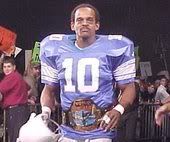MMA/Forbes Article
Oct 5, 2006 18:03:00 GMT -5
Post by LWPD on Oct 5, 2006 18:03:00 GMT -5
Back in the days of public ridicule, political scapegoating, losing PPV clearance and being stuck running shows on Indian reservations...many would be hard pressed to believe that the day would come when MMA would make it into an elite level publication like Forbes with a glowing article on it's prospects. Money and success have always been deadly effective in causing media outlets to experience severe cases of 'the vapors'.
"Damn it feels good to see people up on it. 'Cause I remember when at first they wasn't. Now guess what they caught from my cousin? The vapors!"
-Biz Markie
Courtesy Forbes.com
Ultimate Fighting's Next Battle
R.M Schneiderman, 10/05/06
Last month, roughly 5,000 fans piled into the Memorial Coliseum in Portland, Ore., to watch martial artists Matt "The Law" Lindland and Jeremy "Gumby" Horn battle back and forth. And that they did. In the second round, Lindland snapped a left high kick to Horn's head, appearing to stun him. Horn tried to counter with a kick of his own, but Lindland, 36, followed with a left hook, sending his 31-year-old counterpart to the canvas.
The bout, hosted by the International Fight League, was over in less than five minutes. But the real battle is still raging: What will become the premier organization in mixed martial arts?
The sport, which traces its roots to the vale tudo or "anything goes" fights that became popular in Brazil in the 1920s, combines a wide variety of fighting styles, from boxing to jiu-jitsu. The sometimes bloody battles prohibit head butting, eye gouging, biting, hair pulling and other forms of attack generally considered dangerous or unfair.
In Pictures: Inside Mixed Martial Arts
Since its founding in 1993, a privately owned league called the Ultimate Fighting Championship has been the sport's preeminent brand. In 2001, Frank and Lorenzo Fertitta, who also own Station Casinos (nyse: STN - news - people ) in Las Vegas, bought the UFC for roughly $2 million from entertainment executive Robert Meyrowitz. Since then, they've led the transformation of the sport from a glorified tough-man contest into an increasingly mainstream, money-making sport. With mixed martial arts now legal in 33 states, some say the UFC could eventually rival World Wrestling Entertainment (nyse: WWE - news - people )--a $400 million company (fiscal 2006 sales)--in size and scope.
In 2005, the UFC signed a contract with Viacom's (nyse: VIA - news - people ) Spike TV to produce a reality show called The Ultimate Fighter, the sport's first major cable TV deal. An average 2 million viewers have watched the various seasons of the show each week, and its success helped the UFC launch five other shows on Spike. Last spring, it bolstered its presence on the Internet, launching a video-on-demand service. Customers can now download individual fights for $1.99 apiece.
Television pay per view numbers are also skyrocketing. In July, 775,000 people watched former light heavyweight champion Tito Ortiz defeat UFC hall of famer Ken Shamrock, according to California-based Kagan Research. The fight grossed an estimated $29 million dollars in pay per view revenues.
But no heavyweight champ goes unchallenged for long. Four competitors are now emerging to grapple for a piece of the American market: Pride Fighting Championships, the International Fight League, the World Fighting Alliance and Strikeforce Fighting Championship.
"There isn't room for everybody," says Gareb Shamus, the co-founder of the International Fight League and head of comic book giant Wizard Entertainment. "But there is room for the organizations that have the top talent."
Pride Fighting Championships may be the UFC's strongest competitor. Owned by Tokyo-based Dream Stage Entertainment, which sells out 35,000 seat stadiums in Japan, Pride has arguably more talent than any of its American counterparts, including the UFC. In September, Fox Sports Net began airing bimonthly replays of Pride bouts. And in October, Pride will hold its first U.S. live show, in Las Vegas.
Fortunately for the UFC, Pride is rumored to be struggling financially. In June Fuji TV, the company that broadcasted Pride on television in Japan, canceled its contract due to alleged ties between Pride's parent company and the Japanese mafia.
Other challengers are winning small battles. California-based Strikeforce Fighting Championship broke the mixed martial arts attendance record in March when 18,265 people attended its first show in San Jose. In May, the World Fighting Alliance signed Rampage Jackson, one of the sport's most marketable athletes. And nearly 2 million people watched replays of the International Fight League's first two shows on Fox Sports Net in June. On Aug. 31, the company announced its plans to go public and an initial public offering date should be announced in the next few months.
At some level, of course, the emergence of these rivals is good news for the UFC. They're helping the sport grow, further legitimizing what only five years ago was considered an obscure niche sport. But over time, these startups could potentially drive up costs for talent and dilute the UFC brand.
Still, it's likely that the UFC will remain a dominant player in the sport. "The UFC is like Kleenex," says Josh Gross, the editor of Sherdog.com, the largest combat sports Web site in the country. To many fans, their brand is the sport.
But now things switched without belief
"Yo, Biz, do you remember me from Nobel Street, chief?
We used to be down back in the days."
It happens all the time
And never ceases to amaze
They caught the vapors
-Biz Markie 'The Vapors'
"Damn it feels good to see people up on it. 'Cause I remember when at first they wasn't. Now guess what they caught from my cousin? The vapors!"
-Biz Markie
Courtesy Forbes.com
Ultimate Fighting's Next Battle
R.M Schneiderman, 10/05/06
Last month, roughly 5,000 fans piled into the Memorial Coliseum in Portland, Ore., to watch martial artists Matt "The Law" Lindland and Jeremy "Gumby" Horn battle back and forth. And that they did. In the second round, Lindland snapped a left high kick to Horn's head, appearing to stun him. Horn tried to counter with a kick of his own, but Lindland, 36, followed with a left hook, sending his 31-year-old counterpart to the canvas.
The bout, hosted by the International Fight League, was over in less than five minutes. But the real battle is still raging: What will become the premier organization in mixed martial arts?
The sport, which traces its roots to the vale tudo or "anything goes" fights that became popular in Brazil in the 1920s, combines a wide variety of fighting styles, from boxing to jiu-jitsu. The sometimes bloody battles prohibit head butting, eye gouging, biting, hair pulling and other forms of attack generally considered dangerous or unfair.
In Pictures: Inside Mixed Martial Arts
Since its founding in 1993, a privately owned league called the Ultimate Fighting Championship has been the sport's preeminent brand. In 2001, Frank and Lorenzo Fertitta, who also own Station Casinos (nyse: STN - news - people ) in Las Vegas, bought the UFC for roughly $2 million from entertainment executive Robert Meyrowitz. Since then, they've led the transformation of the sport from a glorified tough-man contest into an increasingly mainstream, money-making sport. With mixed martial arts now legal in 33 states, some say the UFC could eventually rival World Wrestling Entertainment (nyse: WWE - news - people )--a $400 million company (fiscal 2006 sales)--in size and scope.
In 2005, the UFC signed a contract with Viacom's (nyse: VIA - news - people ) Spike TV to produce a reality show called The Ultimate Fighter, the sport's first major cable TV deal. An average 2 million viewers have watched the various seasons of the show each week, and its success helped the UFC launch five other shows on Spike. Last spring, it bolstered its presence on the Internet, launching a video-on-demand service. Customers can now download individual fights for $1.99 apiece.
Television pay per view numbers are also skyrocketing. In July, 775,000 people watched former light heavyweight champion Tito Ortiz defeat UFC hall of famer Ken Shamrock, according to California-based Kagan Research. The fight grossed an estimated $29 million dollars in pay per view revenues.
But no heavyweight champ goes unchallenged for long. Four competitors are now emerging to grapple for a piece of the American market: Pride Fighting Championships, the International Fight League, the World Fighting Alliance and Strikeforce Fighting Championship.
"There isn't room for everybody," says Gareb Shamus, the co-founder of the International Fight League and head of comic book giant Wizard Entertainment. "But there is room for the organizations that have the top talent."
Pride Fighting Championships may be the UFC's strongest competitor. Owned by Tokyo-based Dream Stage Entertainment, which sells out 35,000 seat stadiums in Japan, Pride has arguably more talent than any of its American counterparts, including the UFC. In September, Fox Sports Net began airing bimonthly replays of Pride bouts. And in October, Pride will hold its first U.S. live show, in Las Vegas.
Fortunately for the UFC, Pride is rumored to be struggling financially. In June Fuji TV, the company that broadcasted Pride on television in Japan, canceled its contract due to alleged ties between Pride's parent company and the Japanese mafia.
Other challengers are winning small battles. California-based Strikeforce Fighting Championship broke the mixed martial arts attendance record in March when 18,265 people attended its first show in San Jose. In May, the World Fighting Alliance signed Rampage Jackson, one of the sport's most marketable athletes. And nearly 2 million people watched replays of the International Fight League's first two shows on Fox Sports Net in June. On Aug. 31, the company announced its plans to go public and an initial public offering date should be announced in the next few months.
At some level, of course, the emergence of these rivals is good news for the UFC. They're helping the sport grow, further legitimizing what only five years ago was considered an obscure niche sport. But over time, these startups could potentially drive up costs for talent and dilute the UFC brand.
Still, it's likely that the UFC will remain a dominant player in the sport. "The UFC is like Kleenex," says Josh Gross, the editor of Sherdog.com, the largest combat sports Web site in the country. To many fans, their brand is the sport.
But now things switched without belief
"Yo, Biz, do you remember me from Nobel Street, chief?
We used to be down back in the days."
It happens all the time
And never ceases to amaze
They caught the vapors
-Biz Markie 'The Vapors'




